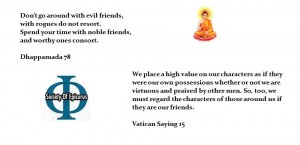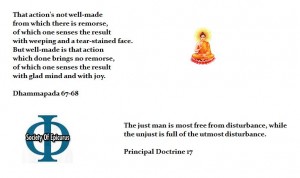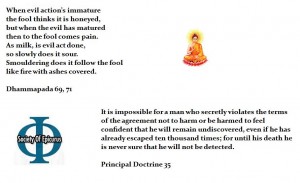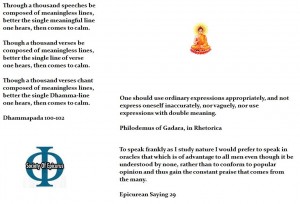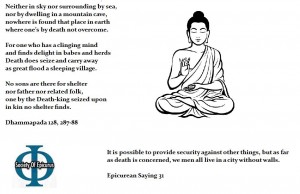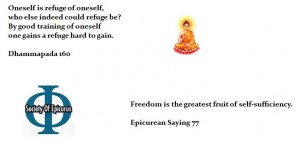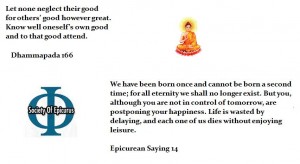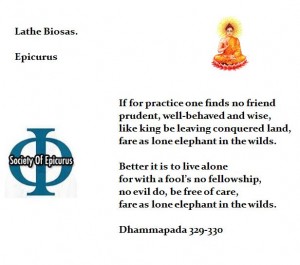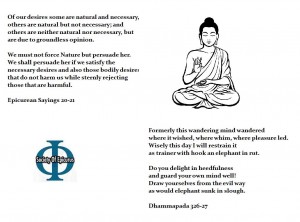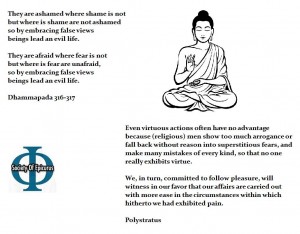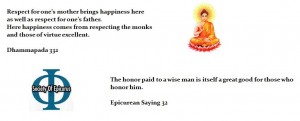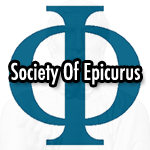The following is a portion of a book review of Why Buddhism is True, by Robert Wright.
I’ve tackled some of the problems related to the Buddhist doctrine of anatta–which posits that there is no self–in my review of Sam Harris’ Waking Up. Is the self a thing? Is it a mental function or a process? Depending on how we define the self, we may or may not find a self. In Why Buddhism is True, in order to prove that there is no-self, Wright limits discussion of the self to “the conscious self”, not the body, not the whole self, which reminds me of Cosma Raimondi’s argument about taking into consideration the whole of the human being. When the author speaks of the self as a “rational charioteer”–presumably meaning “conscious”?–, we are expected to accept that emotions or feelings are perceived as unconscious insofar as they are irrational, and that therefore there is no self, only nature acting as a puppeteer.
Another error in attempting to prove the doctrine of anatta goes back all the way to Siddhartha, the historical Buddha, and appears to be tied to the original Vedic and Hindu context. In the Bhagavad Gita and other Hindu scriptures, we find a defense of the idea of atman (the soul, in Sanskrit) as “the eternal aspect” of our self. This atman is sometimes described, interestingly, as an atomic particle. If Buddha could prove that there was nothing eternal in the sentient being, he could refute the doctrine of atman with a doctrine of anatta (no-self, in Pali). But what if the self, like all else, was real, just temporary? Why does the temporary conglomeration of certain conditions imply non-existence or non-reality? This does not follow, and so the arguments for the doctrine of anatta were, from the onset, flawed, because there is no atman to speak of in the first place. Selfhood does not need to be eternal in order to exist and be experienced as real by sentient beings. If the doctrine of anatta is reinterpreted to say that the self does not exist as_we_imagine_it_to_exist, then there is much more merit to the doctrine.
Now, in nature we see that even seemingly stable things like stones and mountains undergo geological processes over the aeons. We see that the trees can not exist without seeds sprouting, without solar light, without water, soil, and other elements, and that all things inter-exist. We see that, like all animals, we have millions of micro-organisms in our bellies without which we would not be able to properly digest our food: nothing exists in a vacuum. We are constantly exchanging particles with the rest of nature via breathing, acting, and eating. This recycling of particles between all things is poetically detailed early in the first book of Lucretius’ On the Nature of Things, inferring from phenomena like how the sea is replenished by rains, rivers, and other sources of water, and concluding that–since “nothing comes from nothing”–all things must deteriorate into the primal “germs” (that is, particles) that will make up new things:
Whence may the water-springs, beneath the sea,
Or inland rivers, far and wide away,
Keep the unfathomable ocean full?And out of what does Ether feed the stars?
For lapsed years and infinite age must else
Have eat all shapes of mortal stock away:
But be it the Long Ago contained those germs,
By which this sum of things recruited lives,
Those same infallibly can never die,
Nor nothing to nothing evermore return.
If all other things in nature exist as processes, ever-changing, why must a member of the homo sapiens species exist as a Platonic essence, an eternal soul, an abstraction, an idea? Why can’t the self also be a process, just like the body and embedded within it, ever-changing from birth to death? Why can’t there be a concrete self, rather than an abstract self? What if, rather than a noun (self), we started referring to a process of ever becoming, which would more aptly describe what we are referring to–and yet doesn’t deny its reality as a felt experience of the sentient being?
The reason why Buddhists have not found a self is because they are not LOOKING for a CONCRETE self. They are looking for an abstraction, a Platonic “essence”, a Hindu atman. I believe that, with the help of Epicurean and Lucretian descriptions, and drawing strictly from the study of nature, it is possible for contemporary materialists to posit a theory of self that is corporeal, scientific, satisfying, and dynamic, to counter the Buddhist, nihilist, and other theories out there.
For the sake of clarity, Epicurean philosophy finds itself in the realist camp of this discussion–our position is pragmatic: we argue that the reality of the self matters. Sam Harris, Daniel Dennett, and the Buddhists are on the anti-realist side of the debate.
To my knowledge, at least one scientific theory of concrete self has been advanced, and it has some of the features of the Buddhist doctrine of the aggregates (here described as “five dimensions”). It posits that the self is multitudinous and multi-disciplinary. Şerife Tekin presented her theory in an Aeon essay titled Self-Evident:
According to this model, the self is a dynamic, complex, relational and multi-aspectual mechanism of capacities, processes, states and traits that support a degree of agency. The multitudinous self has five distinct but functionally complementary dimensions: ecological, intersubjective, conceptual, private, and temporally extended. These dimensions work together to connect the individual to her body, her social world, her psychological world, and her environment.
Notice that Tekin mentions the feature of agency. Agency, or the ability to act over matter, is one of the attributes that proves the existence of a self Epicurean writings: a void can only be acted upon and has no agency. In other words, agency implies corporeal existence. In the Letter to Herotodus, Epicurus argues that the soul is made up of atoms, that it exists fully embedded into the body and provides it with sentience. As proof that it is corporeal, Epicurus cites how–unlike empty space–it can act and be acted upon.
There is the further point to be considered, what the incorporeal can be, if, I mean, according to current usage the term is applied to what can be conceived as self-existent. But it is impossible to conceive anything that is incorporeal as self-existent except empty space. And empty space cannot itself either act or be acted upon, but simply allows body to move through it. Hence those who call soul incorporeal speak foolishly. For if it were so, it could neither act nor be acted upon. But, as it is, both these properties, you see, plainly belong to soul.
What else does Epicurean tradition have to say regarding the concrete soul? In the Letter to Herodotus, Epicurus argues:
Next, keeping in view our perceptions and feelings (for so shall we have the surest grounds for belief), we must recognize generally that the soul is a corporeal thing, composed of fine particles, dispersed all over the frame … Still, it would not have had sensation, had it not been somehow confined within the rest of the frame.
Epicurus believed that the “soul” particles were finer or more subtle than other particles in the body. Contemporary science, instead, gives us the neurological system which, like the Epicurean soul, is entirely embedded into the body. It runs through the nervous system and is concentrated in two main organs: the brain, and the stomach–which contains enough neurons to be about the size of the brain of a small dog or cat. The Letter to Herodotus says that it is the soul that gives the body sentience.
But the rest of the frame, though it provides this indispensable conditions for the soul, itself also has a share, derived from the soul, of the said quality; and yet does not possess all the qualities of soul. Hence on the departure of the soul it loses sentience. For it had not this power in itself; but something else, congenital with the body, supplied it to body: which other thing, through the potentiality actualized in it by means of motion, at once acquired for itself a quality of sentience, and, in virtue of the neighborhood and interconnection between them, imparted it (as I said) to the body also.
Hence, so long as the soul is in the body, it never loses sentience through the removal of some other part. The containing sheaths may be dislocated in whole or in part, and portions of the soul may thereby be lost; yet in spite of this the soul, if it manage to survive, will have sentience. But the rest of the frame, whether the whole of it survives or only a part, no longer has sensation, when once those atoms have departed, which, however few in number, are required to constitute the nature of soul.
That the soul is corporeal and mortal, and leaves the body at the moment of death, is also argued by Lucretius in De Rerum Natura. There are other materialist theories of self that do not contradict, but in fact may add support to, the theories here presented. In a previous essay, I echoed a materialist conception of identity based on habitual behavior, which not only recognizes the concrete and changing self, but allows for the possibility of cultivation or sculpting of an ethically better self, that is, moral development–a subject that is very in tune with natural philosophy:
“We are what we repeatedly do. Excellence is not an act, but a habit.” –Will Durant
To the extent that habitual behavior is unconscious or subconscious, it can be said to be a crystallized–even if capable of change or evolution–part of the self. This is a different way of thinking about identity, and yet it does not contradict Tekin’s model.
FEELINGS AS ARBITERS OF THOUGHT
In Why Buddhism is True, feelings are explained as **the** value-setting faculty. The author is really a champion of the primacy of feelings over reason in human behavior, arguing that the cognitive and effective / emotional functions are very intertwined. This is the premise behind Epicurean cognitive therapy: that reason and feeling can coach each other.
Feelings are, among other things, your brain’s way of labeling the importance of thoughts, and importance (in natural selection’s somewhat crude sense of the term) determines which thoughts enter consciousness. – Why Buddhism is True (p. 119)
Feelings tell us what to think about, and after all the thinking is done, they tell us what to do. – Why Buddhism is True (p. 124)
Read the rest of the review here.

